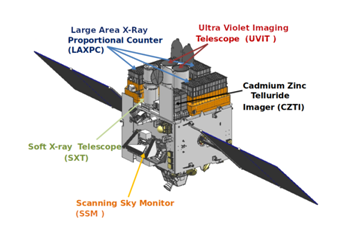

22th February 2023 (9 Topics)
Context
The Indian Space Research Organisation (ISRO) has made an Announcement of Opportunity (AO) to allow scientists and researchers to analyse data from the first dedicated Indian astronomy mission, AstroSat.
About
About the development:
- The space agency has made the AO soliciting proposals for 13th AO cycle observations from AstroSat.
- Eligible participants: The mission data was kept open to Indian scientists, and researchers residing and working at institutes, universities and colleges in India for 55% of the time and to non-Indian scientists, researchers, Non-Resident Indians (NRIs), working at space agencies, institutes, universities and colleges around the globe for 20% time.
- The AO is open to scientists and researchers who are involved in research in the area of astronomy and who are equipped to submit proposals as Principal Investigators (PIs) for specific target observations with necessary scientific and technical justification.
- This AO soliciting proposal is for Indian as well as international proposers as PIs to utilise AstroSat observatory time.
- The percentage of observing time for executing AO proposals from October 2023 to September 2024 is 87 %. The last date for submission is March 31.

AstroSat Mission:
- AstroSat is the first dedicated Indian astronomy mission aimed at studying celestial sources in X-ray and UV spectral bands simultaneously, providing a space astronomy observatory operated by ISRO.
- AstroSat was launched in 2015 and completed seven years in orbit at the end of September 2022.
- Features:
- AstroSat with a lift-off mass of 1515 kg launched into a 650 km orbit.
- The minimum useful life of the AstroSat mission is expected to be 5 years.
- Study conducted:
- To understand high energy processes in binary star systems containing neutron stars and black holes.
- Estimate magnetic fields of neutron stars.
- Study star birth regions and high energy processes in star systems lying beyond our galaxy.
- Detect new briefly bright X-ray sources in the sky.
- Perform a limited deep-field survey of the Universe in the Ultraviolet region.
More Articles



